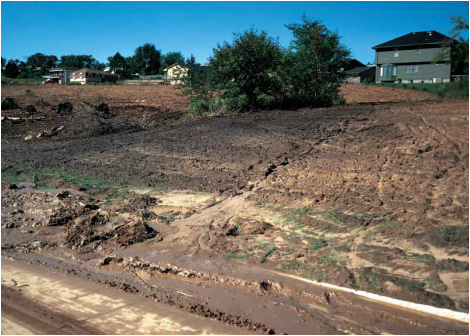Erosion Control

Controlling erosion on urban or suburban sites, particularly during and after construction, is a common problem.
Here are some simple suggestions which may help you in reducing erosion on your site.
Grading
Limit the amount of grading to an area not much bigger than will be built upon. This reduces the amount of bare soil exposed to erosion. It also maintains existing vegetation on the land that can help protect the soil.
Silt fence & straw bale barriers
Silt fence and straw bales are installed around the perimeter of most construction sites to keep soil erosion from moving off the site. However, maintenance of these practices throughout construction is key to these measures being effective barriers in reducing erosion both on and off-site.
Replacing damaged silt fence and/or re-erecting fence that has been knocked down during construction is easy to do, and should be done on a regular basis. Replacing straw bales that have fallen apart or decomposed should also be done routinely.
Less Pavement & Stormwater Detention
With construction comes roads, parking lots, sidewalks and building roofs that are impervious and do not allow water to soak into the ground.
Using paving stones or materials that allow water to filter through them, and reducing the size of parking lots will help reduce the amount of stormwater that will runoff a site, causing erosion as it moves.
Building and maintaining stormwater detention ponds will help reduce erosion by storing and releasing stormwater at controlled rates.
Seeding & Mulching
Where grading of large areas is required, exposed soil can be protected from erosion during construction by using temporary seedings and mulch, until permanent vegetation can be established.
Consider planting varieties that require less intensive routine maintenance and good soil holding capabilities. Check with your local landscapers and nurseries/garden centers for ideas. The Conservation District also offers for sale native wildflower and prairie grass plants. The District also has catalogs of sources of wildflower seed, for larger plantings.
Hydroseeding grass; mulch blankets, geotextile fabrics and other products can help keep steep slopes, road ditches and stream banks from eroding.
Tree Protection
Keeping as many naturally occurring trees on your site as possible, is highly encouraged. This will not only help reduce erosion during construction, but also provide you a head start with landscaping, and faster shade and wind protection than provided by newly planted, usually smaller trees.
After picking desirable trees to keep, erect snow fence around the trees to be saved, at the drip-line, or outside edge of the tree canopy. This will help to keep equipment from compacting the soil over the major portion of the tree root system, as well as stopping physical damage to the tree.
Just placing fence around the trunk of the tree is not sufficient to protect the tree and its roots. You may be disappointed to see the tree die a year or two after construction is complete, because of compacted soil and damaged roots.
Erosion Control Plan
Most urban and suburban sites in Washtenaw County require permits and the development of detailed plans to control soil erosion during and following construction.
These permits and plans are approved by city, township or county officials. For information on permits and developing an erosion control plan on your site, contact your local city building department, township office, or the Washtenaw County Soil Erosion and Sedimentation Control, phone: (734) 222-3829.
The Washtenaw County Conservation District and USDA Natural Resources Conservation Service can also provide recommendations on erosion control measures and seedings appropriate for your site, upon request.
For more information, contact the District Office at: (734) 761-6721 x 5.
Resources
Here are some simple suggestions which may help you in reducing erosion on your site.
Grading
Limit the amount of grading to an area not much bigger than will be built upon. This reduces the amount of bare soil exposed to erosion. It also maintains existing vegetation on the land that can help protect the soil.
Silt fence & straw bale barriers
Silt fence and straw bales are installed around the perimeter of most construction sites to keep soil erosion from moving off the site. However, maintenance of these practices throughout construction is key to these measures being effective barriers in reducing erosion both on and off-site.
Replacing damaged silt fence and/or re-erecting fence that has been knocked down during construction is easy to do, and should be done on a regular basis. Replacing straw bales that have fallen apart or decomposed should also be done routinely.
Less Pavement & Stormwater Detention
With construction comes roads, parking lots, sidewalks and building roofs that are impervious and do not allow water to soak into the ground.
Using paving stones or materials that allow water to filter through them, and reducing the size of parking lots will help reduce the amount of stormwater that will runoff a site, causing erosion as it moves.
Building and maintaining stormwater detention ponds will help reduce erosion by storing and releasing stormwater at controlled rates.
Seeding & Mulching
Where grading of large areas is required, exposed soil can be protected from erosion during construction by using temporary seedings and mulch, until permanent vegetation can be established.
- Temporary
- Use Existing Vegetation
- Permanent
Consider planting varieties that require less intensive routine maintenance and good soil holding capabilities. Check with your local landscapers and nurseries/garden centers for ideas. The Conservation District also offers for sale native wildflower and prairie grass plants. The District also has catalogs of sources of wildflower seed, for larger plantings.
Hydroseeding grass; mulch blankets, geotextile fabrics and other products can help keep steep slopes, road ditches and stream banks from eroding.
Tree Protection
Keeping as many naturally occurring trees on your site as possible, is highly encouraged. This will not only help reduce erosion during construction, but also provide you a head start with landscaping, and faster shade and wind protection than provided by newly planted, usually smaller trees.
After picking desirable trees to keep, erect snow fence around the trees to be saved, at the drip-line, or outside edge of the tree canopy. This will help to keep equipment from compacting the soil over the major portion of the tree root system, as well as stopping physical damage to the tree.
Just placing fence around the trunk of the tree is not sufficient to protect the tree and its roots. You may be disappointed to see the tree die a year or two after construction is complete, because of compacted soil and damaged roots.
Erosion Control Plan
Most urban and suburban sites in Washtenaw County require permits and the development of detailed plans to control soil erosion during and following construction.
These permits and plans are approved by city, township or county officials. For information on permits and developing an erosion control plan on your site, contact your local city building department, township office, or the Washtenaw County Soil Erosion and Sedimentation Control, phone: (734) 222-3829.
The Washtenaw County Conservation District and USDA Natural Resources Conservation Service can also provide recommendations on erosion control measures and seedings appropriate for your site, upon request.
For more information, contact the District Office at: (734) 761-6721 x 5.
Resources

